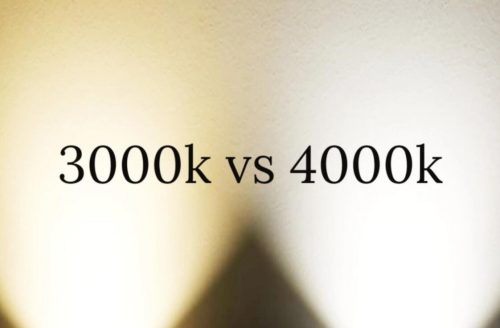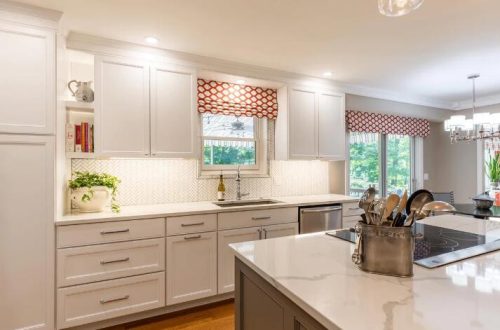
When contemplating the illumination of your well-loved, the consideration of color temperature undeniably emerges as a pivotal factor. This crucial parameter, typically gauged in Kelvin (K), delineates the exquisite interplay between the warmth and coolness exuded by the luminosity. Oftentimes, people at home are choosing from two favorites – 3000K and 4000K.
Learning the intricacies of both the 3000K and 4000K lighting variants enables you to discern with precision the ideal choice that harmonizes flawlessly with the unique ambiance of your abode. Here we take a dive into their effects on emotion, practicality, well-being, and aesthetics – to help you make a wise choice.
From mood enhancements to positive impacts on health, there’s no denying that lighting plays an integral role in any interior design scheme.
Color Temperature - A Brief Rundown

Before we get through the details of 3000K and 4000K lighting, let us initially discuss color temperature in a short and simple way.
When it comes to the visual portrayal of light, color temperature serves as a means to articulate its chromatic essence. Expressed in Kelvin (K), this quantifiable parameter traverses the spectrum from a cozy, amber-toned radiance to a brisk, cerulean glow.
Lower Kelvin values are indicative of a mellower, warmer luminosity, whereas higher Kelvin values signify a crisper, cooler demeanor.
An Overview of 3000K Lighting

3000K lighting is known for its warm, welcoming hue – gently yellow and much like the timeless sensation of incandescent bulbs. Soft yet cozy, the light instantly fills any space with a friendly atmosphere. There’s something comforting about having it in your home; like having an extra source of comfort during those dark winter nights.
With its warm and alluring radiance, lighting set at 3000K brings a delightful illumination to residential areas, such as bedrooms, living rooms, and dining rooms.
It adds that special touch to any earthy-hued decor scheme.
This particular lighting choice is a splendid match for homes adorned with a snug color palette, as it effortlessly engenders a welcoming and intimate ambiance, where coziness takes center stage. However, it might not be up to snuff if your work requires exact color discernment or ample visibility.
Therefore, it is less suitable for areas like kitchens, home offices, or workspaces where task lighting is crucial.
An Overview of 4000K Lighting

4000K lighting falls into the cool white category. It emits a brighter, whiter light with a slight blue tint. This color temperature is often associated with daylight and can create a more vibrant and stimulating atmosphere.
4000K lighting has become the go-to choice in both commercial and industrial spaces, particularly for tasks that require direct illumination. With its relaxed yet vivid luminescence, it casts an air of cool brightness – a perfect complement to the environment.
If you’re rocking a predominantly white or cool-toned area like a kitchen with white cupboards and such, then 4000K lighting can be just the ticket for adding some extra brightness and crystal clarity.
No doubt, it’s perfect for chores that ask for accuracy and concentration. That makes it a great option in the kitchen, bathroom, home office, or any workplace.
3000K vs 4000K Lighting: The Overall Effect on Mood
Undeniably, the ambient temperature of each luminous fixture exerts a profound influence on the atmospheric disposition of any given environment. The interplay between illumination and emotion is an intricate dance as lighting possesses the remarkable ability to stir specific sentiments and establish a distinct ambiance.
With the 3000K lighting, you will achieve a cozy glow that pushes you to savor the ambiance. Whether it’s your bedroom or living room – these lights create an inviting atmosphere perfect for unwinding.
Contrastingly, 4000K lighting brings in a brilliant and lively atmosphere. It really amps up the energy level, thus supporting focus and alertness that would be necessary – like when pounding away at work in clumsy home offices or concentrative study areas.
In terms of cooler luminosity, a heightened state of alertness and engagement takes root, rendering it a good choice for endeavors necessitating unwavering focus. The discerning utilization of this invigorating light variant caters seamlessly to activities that demand resolute concentration and unwavering cognitive focus.
3000K vs 4000K Lighting: Practicality and Functionality
In the quest for the most fitting illumination within your abode, prudent contemplation of the functional merits of diverse color temperatures becomes imperative.
The enchanting radiance emitted by 3000K lights is typically harnessed for the purpose of accentuating elements and setting the stage with an inviting allure across multiple chambers.It works perfectly as general illumination where you want to feel chilled-out – perfect for living rooms or bedrooms after a long day.
For endeavors that demand an added measure of focus, the unequivocal choice lies with 4000K lighting. Exhibiting a cooler and more vibrant chromatic disposition, this particular hue bestows upon its surroundings an elevated state of attentiveness, endowing you with the clarity and precision requisite for the successful execution of your tasks.
Whether you find yourself engaged in the culinary arts within your kitchen domain or immersed in the pursuit of creative projects within the confines of your home office, the resolute brilliance of 4000K lighting stands ready.
3000K vs 4000K Lighting: The Impact on Human Health
Lighting exercises a profound influence on our physical and psychological welfare, particularly when it comes to the delicate balance of our sleep patterns and circadian rhythms.
The prevalence of blue light, notably abundant in cooler color temperatures, can wreak havoc in our sleep-wake cycles. By stifling the production of melatonin, the hormone essential for regulating sleep, it instigates considerable obstacles in both the onset and maintenance of a restful slumber or a sustained state of wakefulness.
In this context, 3000K lighting emerges as a potential ally. Its warmer color temperature manifests in a diminished presence of blue light, thereby facilitating the cultivation of an environment conducive to tranquility, particularly within sanctuaries like bedrooms or spaces specifically designed to foster relaxation.
On the other hand, if you use 4000K lighting in the evening, it’s crucial to consider the potential impact on your sleep. It’s advisable to limit exposure to cooler light before bedtime to ensure more restorative sleep.
3000K vs 4000K Lighting: Interior Aesthetics
When contemplating the selection between 3000K and 4000K lighting, it behooves us to contemplate the broader panorama of our interior aesthetics. The light you pick makes all the difference in how colors appear, as well as adding a little something extra to the atmosphere.
If you’re rocking warm tones or trying for an earthy aesthetic inside – 3000K provides that feeling of comfort that accentuates the color scheme perfectly.
On the contrary, supposing that your house is adorned with a preponderance of cool or alabaster colors, the inclusion of 4000K lighting holds the potential to imbue your living spaces with a sense of unadulterated precision and clarity.
This is particularly beneficial in areas like kitchens or bathrooms where cleanliness and visibility are pivotal.
Pros and Cons of 3000K Lighting for Your Home

Pros:
- Warm and Cozy Atmosphere. Embracing a luminous spectrum resonating at 3000K, an alluring radiance suffuses your house, beckoning solace and respite in sanctuaries of repose like bedrooms, lounges, and dining spaces.
- Complements Warm Color Schemes. The all-encompassing glow emitted by 3000K lighting, suffused with a gentle amber hue, seamlessly harmonizes with fervent palettes and rustic chromatic tapestries, thereby amplifying the holistic allure of your internal milieu.
- Suitable for Residential Spaces. Revered as the quintessence of domestic luminosity, 3000K lighting has become customary in residential domains, courtesy of its snuggly and heartening aura. It provides a sense of familiarity and homeliness.
- Exemplary for Illuminating Ambiance and Accentuation. The gentle luminescence exuded by 3000K lighting constitutes an exquisite choice for orchestrating ambient and accent illumination.
- Can Help Promote Relaxation. LED luminaries boasting a color temperature of 3000K or below foster an environment of tranquility and serenity, evoking a serene ambiance.
Cons:
- Limited Visibility. When contrasted to its cooler counterparts, 3000K lighting may exhibit diminished visibility and luminosity, constituting a drawback in locales necessitating task-oriented or meticulous endeavors.
- Not Suitable for Cool Color Schemes. The warm tones of 3000K lighting may clash with cool color schemes, so it’s important to consider the overall color palette of your space before opting for this color temperature.
- May Not Provide Sufficient Task Lighting. Should you possess enclaves within your house mandating resplendent and targeted illumination for activities like studying or kitchen tasks, the gentle radiance of 3000K lighting might not bestow the requisite brilliance.
Pros and Cons of 4000K Lighting for Your Home

Pros:
- Bright and Vibrant Lighting. 4000K lighting evinces a cooler and brighter radiance, adroitly tailored for spaces where visual acuity and crystalline precision assume paramount importance, such as culinary arenas, corporate suites, and industrious workstations.
- Suitable for Cool Color Schemes. The bluish tint of 4000K lighting complements cool color schemes and white surfaces, making it a great choice for modern and contemporary interiors.
- Ideal for Task Lighting. Applying both brilliance and color temperature conducive to assiduous undertakings, the luminosity released by 4000K lighting yields clarity, thus serving as an instrumental ally in augmenting concentration and productivity.
- Widely Utilized in Industrial or Commercial Areas. 4000K lighting is commonly used in commercial and industrial spaces due to its ability to illuminate large areas and provide optimal visibility for tasks and safety.
- Versatile Outdoor Lighting. The arctic-white radiance emitted by 4000K lighting frequently finds employment in illuminating open-air domains, particularly in vast parking lots, fortified areas, and other locales where heightened visibility becomes an imperative.
Cons:
- Less Cozy Atmosphere. In comparison to 3000K lighting, 4000K lighting may engender an atmosphere that is less snug and intimate. Thus, it may not prove as ideal for spaces where the primary objectives lie in fostering relaxation and unwinding.
- Not Recommended for Bedrooms. The brilliant effect of 4000K lighting may prove less than ideal for bedroom sanctuaries as its intensity can be overpowering.
- Potential Disruption of Sleep Patterns. Studies indicate that exposure to cool white light, exemplified by the 4000K lighting spectrum, during nocturnal hours can impede natural sleep patterns and disrupt the harmonious rhythms of the body’s internal clock.
Best Applications of 3000K and 4000K Lighting
The following are prevailing applications for both 3000K and 4000K lighting:
3000K Lighting:
- Bedrooms, living spaces, as well as dining areas
- Accent and ambient lighting
- Other rooms with warm as well as cozy environments
- Residential spaces with warm or earthy tones
4000K Lighting:
- Kitchens, bathrooms, and home offices
- Task lighting and workspaces
- Bright and energetic environments
- Commercial and industrial spaces
- Spaces with predominantly white or cool-toned interiors
Final Words
In the quest for the ideal illumination for your abode, it becomes paramount to deliberate upon an array of factors encompassing color temperature, ambiance, functionality, well-being, and interior aesthetics.
Both 3000K and 4000K lighting options have their distinct advantages and applications. Understanding these differences can help you create the desired atmosphere and functionality for each space in your home.
If you want your home to feel like a warm hug or be alive with energy, there is an ideal color temperature, which will give you what you need.






